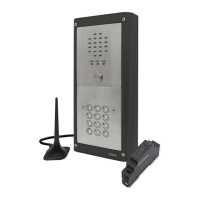66250675-EN - V1.0 - 05/09/17
32
4000 Series Vandal Resistant GSM - Technical Manual
4000 Series Vandal Resistant GSM Audio Intercom with Proximity Facility
Fitting the SIM & Connecting Power
FITTING THE SIM CARD AND CONNECTING THE POWER TO THE GSM INTERCOM
After connecting the power supply, antenna, lock output and any auxiliary devices as shown in this manual and before powering
up, a SIM card must be installed (the SIM must already be registered with the network provider). The SIM holder can be found on the
back of the module next to the SMA antenna connection. A SIM card from most network providers can be used with the exception
of the 3 network. Follow the steps below to insert the SIM card:
1. On the GSM module slide the SIM holder on the back
of the unit to the right until it ‘clicks’, as shown in Fig.34.
2. The SIM holder is hinged and will open out to the right,
see Fig.35.
3. Place the SIM card into the holder (it will only t one
way, see Fig.36) and fold the holder back down, see
Fig.37.
4. Slide the SIM holder back to the left until it ‘clicks’, see
Fig.38.
5. Once the SIM is in place connect the appropriate call
buttons following the example shown in Fig.3 and
using the table on page 7 of this manual.
6. Connect the Art.432 GSM antenna and then connect
the DR-15-12, 12Vdc power supply but DO NOT power
up the system yet.
7. Follow the initialisation process described below.
Fig. 34 Fig. 35
Fig. 36 Fig. 37
Fig. 38
POWER UP INITIALISATION SEQUENCE
The GSM module requires approximately 30 seconds to initialise properly. We recommend
NOT sending SMS messages or pressing buttons during this time.
1. First check all the connections have been made correctly and then power up the
system.
2. Two short beeps will be heard from the GSM module and the busy LED will switch
ON, as shown in Fig.39.
3. After approximately 10 seconds the busy LED will start to ash for a further 10
seconds and then emit a single beep, as shown in Fig.40.
4. The busy LED will continue to ash while it registers with the chosen network.
5. After a further delay the busy LED will stop ashing to indicate that the GSM module
has registered with the network and is ready to begin programming.
If you hear a dierent combination of beeps during the initialisation process then you
can nd the meaning of these beeps towards the back of the manual.
Fig. 39
Fig. 40
SPEAK BUSY OPEN
SPEAK BUSY OPEN

